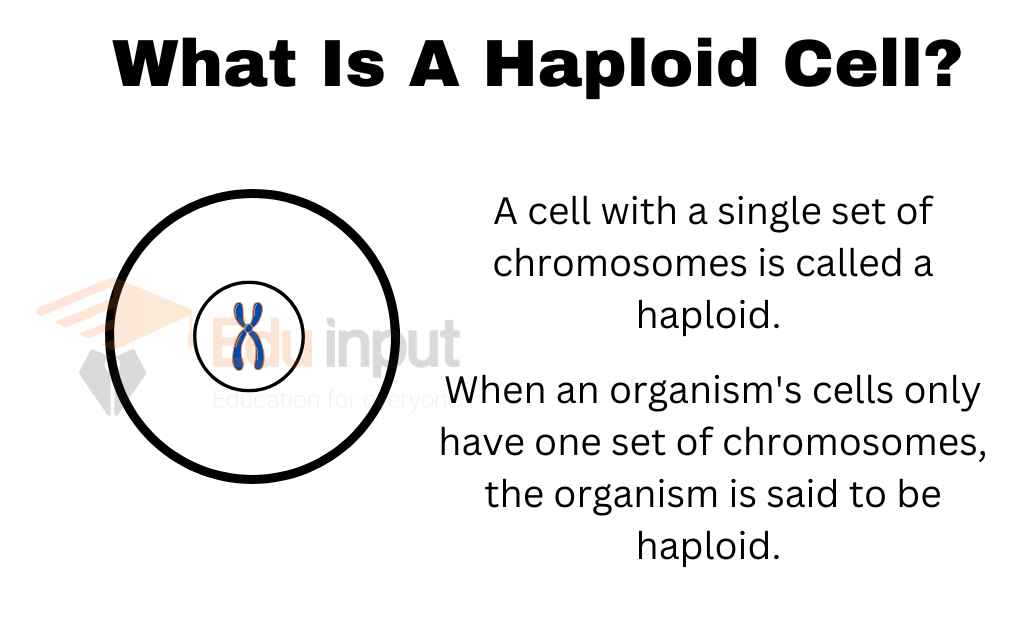What Is A Haploid Cell?-Definition, Example | What Is A Haploid Organism?
When an organism’s cells only have one set of chromosomes, the organism is said to be haploid, and one set of chromosomes makes up a haploid cell. All organisms that reproduce sexually are diploid (having two sets of chromosomes, one from each parent).
Only the egg and sperm cells in humans are haploid.
Meiosis, a specific type of cell division where the genetic material of the parent cell is divided twice, is how the egg and sperm cells are created in humans. As a result, these haploid cells have just one set of chromosomes.

The genetic material is integrated into the zygote cell that results from sperm fertilizing an egg. In other words, two distinct haploid cells with one set of chromosomes each combine to form a single diploid cell with two sets of chromosomes.
In the end, that zygote cell develops into a new individual. Intriguingly, in some insect species, such as wasps, bees, and ants, the females are diploid and develop from fertilized eggs while the males develop from unfertilized eggs.
What Is A Haploid Cell?
A cell with a single set of chromosomes is called a haploid. The number of chromosomes in sperm or egg cells, often known as gametes, is also known as haploid. In humans, gametes are haploid cells with 23 chromosomes, one of each chromosomal pair found in diploid cells—and are hence haploid. The haploid number, commonly known as n, is used to indicate the number of chromosomes in a single pair. It is n = 23 for humans.
The normal diploid body cells, commonly known as somatic cells, have half chromosomes so do gametes. Meiosis, a type of cell division in which the number of chromosomes in a parent diploid cell is reduced by half, is the process that results in the production of haploid gametes.
How Are Haploid Cells Produced?
Humans produce haploid cells during meiosis. A single diploid parent cell divides into four different haploid daughter cells in this type of cell division. Meiosis is a crucial step before sexual reproduction because it produces gametes.
The diploid parent cell creates exact replicas of each of its chromosomes before the start of meiosis. These days, a centromere connects the two sister chromatids (DNA strands that are genetically identical) on each chromosome.
The freshly replicated chromosomes then align in their homologous pairs during meiosis I, which the cell goes through. At this moment, a process known as crossing over occurs where the homologous pairs exchange genetic material with one another.
The sister chromatids are no longer genetically similar. Each newly formed cell acquires one chromosome (made up of two sister chromatids) from each homologous pair when the cell divides. Two haploid, non-identical daughter cells are created as a result.
The two haploid daughter cells formed after meiosis I divide once more during meiosis II. This time, one sister chromatid from each homologous pair is contributed to each new daughter cell instead of the DNA being copied. Thus, meiosis II results in the formation of four non-identical haploid daughter cells.
Example Of A Haploid Organism
Algae are species that have haploid phases of their life cycle. Some organisms, such as male ants, are haploid across their entire life cycle.
Gametes are an example of haploid cells (male or female germ cells).
Are Humans Haploid Organisms?
Human cells are typically diploid (two copies of each chromosome) as opposed to haploid (one copy of each chromosome).
In humans, 23 chromosomes are found in each of the haploid cells (male and female germ cells) that make up gametes. After fertilization, these gametes develop a diploid zygote, having two sets of chromosomes, one from each parent. Humans are therefore diploid organisms.
Research In Field Of Haploid Cell
Scientists have induced haploid cell development in carrot plants to produce homozygous doubled haploid lines for use in breeding programs, as an alternative to conventionally derived inbred lines. Androgenesis, gynogenesis, and induced parthenogenesis methods have been used, with potential discussed. CENH3 manipulation is also acknowledged. [1]
Scientists established seven continuous cell lines in vitro from lethal embryos of the Drosophila melanogaster mutant mh 1182, with six lines showing haploid metaphases. Karyotype analysis revealed high levels of aneuploidy and chromosome fragments. Stable haploid clones were isolated from two lines, and crossing experiments showed the haploid genome was of maternal origin. The appearance of diploid cells and conditions for karyotypic stability were analyzed. [2]
Working with bacteria, which have short life cycles and low nutrient requirements, has led to important advances in genetics. These advantages can now be applied to higher plants by working with microspores, which are unicellular haploid cells. [3]

 written by
written by 

Leave a Reply